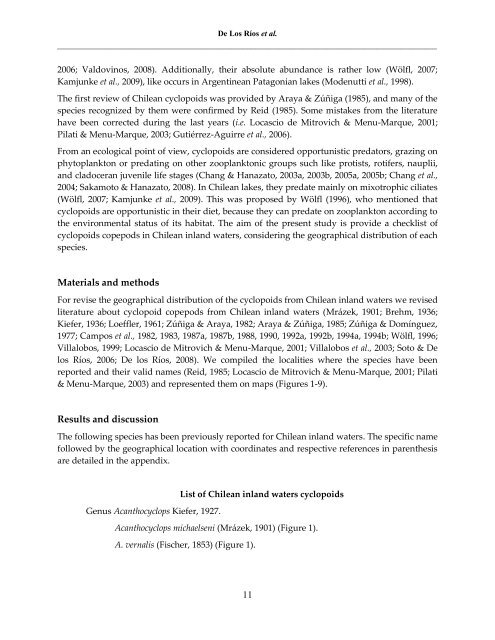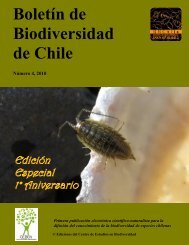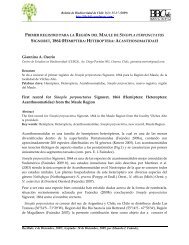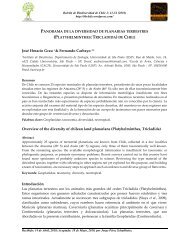PDF - boletÃn de biodiversidad de chile
PDF - boletÃn de biodiversidad de chile
PDF - boletÃn de biodiversidad de chile
You also want an ePaper? Increase the reach of your titles
YUMPU automatically turns print PDFs into web optimized ePapers that Google loves.
De Los Ríos et al.<br />
______________________________________________________________________________________________<br />
2006; Valdovinos, 2008). Additionally, their absolute abundance is rather low (Wölfl, 2007;<br />
Kamjunke et al., 2009), like occurs in Argentinean Patagonian lakes (Mo<strong>de</strong>nutti et al., 1998).<br />
The first review of Chilean cyclopoids was provi<strong>de</strong>d by Araya & Zúñiga (1985), and many of the<br />
species recognized by them were confirmed by Reid (1985). Some mistakes from the literature<br />
have been corrected during the last years (i.e. Locascio <strong>de</strong> Mitrovich & Menu-Marque, 2001;<br />
Pilati & Menu-Marque, 2003; Gutiérrez-Aguirre et al., 2006).<br />
From an ecological point of view, cyclopoids are consi<strong>de</strong>red opportunistic predators, grazing on<br />
phytoplankton or predating on other zooplanktonic groups such like protists, rotifers, nauplii,<br />
and cladoceran juvenile life stages (Chang & Hanazato, 2003a, 2003b, 2005a, 2005b; Chang et al.,<br />
2004; Sakamoto & Hanazato, 2008). In Chilean lakes, they predate mainly on mixotrophic ciliates<br />
(Wölfl, 2007; Kamjunke et al., 2009). This was proposed by Wölfl (1996), who mentioned that<br />
cyclopoids are opportunistic in their diet, because they can predate on zooplankton according to<br />
the environmental status of its habitat. The aim of the present study is provi<strong>de</strong> a checklist of<br />
cyclopoids copepods in Chilean inland waters, consi<strong>de</strong>ring the geographical distribution of each<br />
species.<br />
Materials and methods<br />
For revise the geographical distribution of the cyclopoids from Chilean inland waters we revised<br />
literature about cyclopoid copepods from Chilean inland waters (Mrázek, 1901; Brehm, 1936;<br />
Kiefer, 1936; Loeffler, 1961; Zúñiga & Araya, 1982; Araya & Zúñiga, 1985; Zúñiga & Domínguez,<br />
1977; Campos et al., 1982, 1983, 1987a, 1987b, 1988, 1990, 1992a, 1992b, 1994a, 1994b; Wölfl, 1996;<br />
Villalobos, 1999; Locascio <strong>de</strong> Mitrovich & Menu-Marque, 2001; Villalobos et al., 2003; Soto & De<br />
los Ríos, 2006; De los Ríos, 2008). We compiled the localities where the species have been<br />
reported and their valid names (Reid, 1985; Locascio <strong>de</strong> Mitrovich & Menu-Marque, 2001; Pilati<br />
& Menu-Marque, 2003) and represented them on maps (Figures 1-9).<br />
Results and discussion<br />
The following species has been previously reported for Chilean inland waters. The specific name<br />
followed by the geographical location with coordinates and respective references in parenthesis<br />
are <strong>de</strong>tailed in the appendix.<br />
List of Chilean inland waters cyclopoids<br />
Genus Acanthocyclops Kiefer, 1927.<br />
Acanthocyclops michaelseni (Mrázek, 1901) (Figure 1).<br />
A. vernalis (Fischer, 1853) (Figure 1).<br />
11








